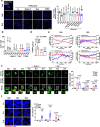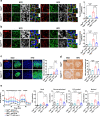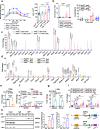Lysosomal Ca2+-mediated TFEB activation modulates mitophagy and functional adaptation of pancreatic β-cells to metabolic stress
- PMID: 35288580
- PMCID: PMC8921223
- DOI: 10.1038/s41467-022-28874-9
Lysosomal Ca2+-mediated TFEB activation modulates mitophagy and functional adaptation of pancreatic β-cells to metabolic stress
Abstract
Although autophagy is critical for pancreatic β-cell function, the role and mechanism of mitophagy in β-cells are unclear. We studied the role of lysosomal Ca2+ in TFEB activation by mitochondrial or metabolic stress and that of TFEB-mediated mitophagy in β-cell function. Mitochondrial or metabolic stress induced mitophagy through lysosomal Ca2+ release, increased cytosolic Ca2+ and TFEB activation. Lysosomal Ca2+ replenishment by ER- > lysosome Ca2+ refilling was essential for mitophagy. β-cell-specific Tfeb knockout (TfebΔβ-cell) abrogated high-fat diet (HFD)-induced mitophagy, accompanied by increased ROS and reduced mitochondrial cytochrome c oxidase activity or O2 consumption. TfebΔβ-cell mice showed aggravation of HFD-induced glucose intolerance and impaired insulin release. Metabolic or mitochondrial stress induced TFEB-dependent expression of mitophagy receptors including Ndp52 and Optn, contributing to the increased mitophagy. These results suggest crucial roles of lysosomal Ca2+ release coupled with ER- > lysosome Ca2+ refilling and TFEB activation in mitophagy and maintenance of pancreatic β-cell function during metabolic stress.
© 2022. The Author(s).
Conflict of interest statement
M.-S.L. is the CEO of LysoTech, Inc. All authors declare no competing interests.
Figures






Similar articles
-
Impaired TFEB activation and mitophagy as a cause of PPP3/calcineurin inhibitor-induced pancreatic β-cell dysfunction.Autophagy. 2023 May;19(5):1444-1458. doi: 10.1080/15548627.2022.2132686. Epub 2022 Oct 10. Autophagy. 2023. PMID: 36217215 Free PMC article.
-
Essential role of lysosomal Ca2+-mediated TFEB activation in mitophagy and functional adaptation of pancreatic β-cells to metabolic stress.Autophagy. 2022 Dec;18(12):3043-3045. doi: 10.1080/15548627.2022.2069956. Epub 2022 May 1. Autophagy. 2022. PMID: 35468040 Free PMC article.
-
Pancreatic β-cell mitophagy as an adaptive response to metabolic stress and the underlying mechanism that involves lysosomal Ca2+ release.Exp Mol Med. 2023 Sep;55(9):1922-1932. doi: 10.1038/s12276-023-01055-4. Epub 2023 Sep 1. Exp Mol Med. 2023. PMID: 37653033 Free PMC article. Review.
-
Carbon monoxide-induced TFEB nuclear translocation enhances mitophagy/mitochondrial biogenesis in hepatocytes and ameliorates inflammatory liver injury.Cell Death Dis. 2018 Oct 17;9(11):1060. doi: 10.1038/s41419-018-1112-x. Cell Death Dis. 2018. PMID: 30333475 Free PMC article.
-
Regulation of lysosomes in skeletal muscle during exercise, disuse and aging.Free Radic Biol Med. 2024 Nov 20;225:323-332. doi: 10.1016/j.freeradbiomed.2024.09.028. Epub 2024 Sep 25. Free Radic Biol Med. 2024. PMID: 39332541 Review.
Cited by
-
Impaired TFEB activation and mitophagy as a cause of PPP3/calcineurin inhibitor-induced pancreatic β-cell dysfunction.Autophagy. 2023 May;19(5):1444-1458. doi: 10.1080/15548627.2022.2132686. Epub 2022 Oct 10. Autophagy. 2023. PMID: 36217215 Free PMC article.
-
HKDC1, a target of TFEB, is essential to maintain both mitochondrial and lysosomal homeostasis, preventing cellular senescence.Proc Natl Acad Sci U S A. 2024 Jan 9;121(2):e2306454120. doi: 10.1073/pnas.2306454120. Epub 2024 Jan 3. Proc Natl Acad Sci U S A. 2024. PMID: 38170752 Free PMC article.
-
Mitochondrial clearance and increased HSF-1 activity are coupled to promote longevity in fasted Caenorhabditis elegans.iScience. 2024 Apr 27;27(6):109834. doi: 10.1016/j.isci.2024.109834. eCollection 2024 Jun 21. iScience. 2024. PMID: 38784016 Free PMC article.
-
TFEB activation triggers pexophagy for functional adaptation during oxidative stress under calcium deficient-conditions.Cell Commun Signal. 2024 Feb 21;22(1):142. doi: 10.1186/s12964-024-01524-x. Cell Commun Signal. 2024. PMID: 38383392 Free PMC article.
-
Key challenges and recommendations for defining organelle membrane contact sites.Nat Rev Mol Cell Biol. 2025 Jun 23. doi: 10.1038/s41580-025-00864-x. Online ahead of print. Nat Rev Mol Cell Biol. 2025. PMID: 40550870 Review.
References
-
- Jung HS, et al. Loss of autophagy diminishes pancreatic b-cell mass and function with resultant hyperglycemia. Cell Metab. 2008;8:318–324. - PubMed
Publication types
MeSH terms
Substances
LinkOut - more resources
Full Text Sources
Molecular Biology Databases
Miscellaneous

